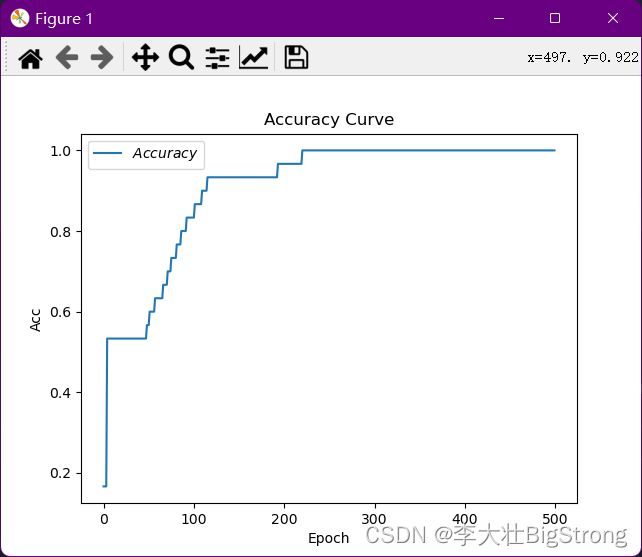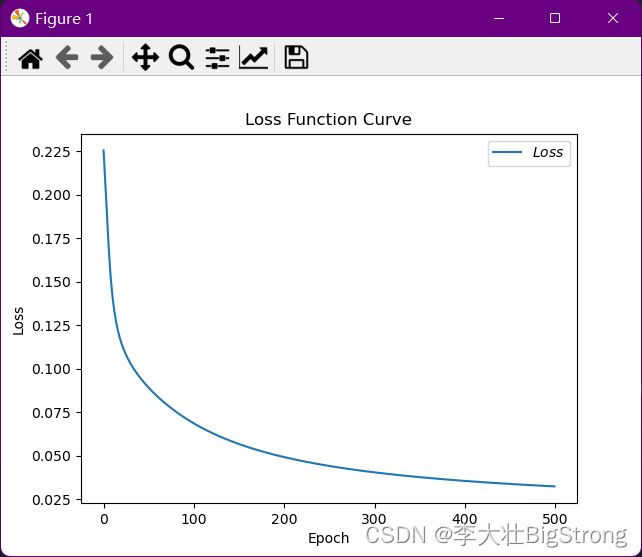tensorflow学习笔记及分类鸢尾花
TensorFlow框架介绍
tensorflow简介
tensorflow 版本:
2019.3 Tensorflow 2.0 测试版发布
2019.10 Tensorflow 2.0 正式版发布
2020.1 Tensorflow 2.1 发布
2020.5 Tensorflow 2.2 发布
2020.7 Tensorflow 2.3 发布
2020.12 Tensorflow 2.4 发布
张量
张量(Tensor):多维数组(列表) 阶:张量的维数
| 维数 | 阶 | 名字 | 例子 |
|---|---|---|---|
| 0-D | 0 | 标量 scalar | s = 1 2 3 |
| 1-D | 1 | 向量 vector | v = [1, 2, 3] |
| 2-D | 2 | 矩阵 matrix | m = [[1, 2, 3],[4, 5, 6]] |
| 3-D | N | 张量 tensor | t = [[[(n个[)]]] |
张量可以表示0阶到n阶数组(列表)
数据类型
- tf.int, tf.float
- uf.int32, tf.float 32, tf.float 64
- tf.bool
- tf.constant([True, False])
- tf.string
- tf.constant(“Hello, world!”)
如何创建一个Tensor
创建一个张量
tf.constant(张量内容, dtype=数据类型(可选))
import tensorflow as tf
a = tf.constant([1,5], dtype=tf.int64)
print(a)
print(a.dtype)
print(a.shape)
tf.Tensor([1 5], shape=(2,), dtype=int64) # 有一个逗号,说明是1维,2说明这个张量里面有两个元素
<dtype: 'int64'>
(2,)
tf.convert_to_tensor 将numpy的数据类型转换为Tensor数据类型
import tensorflow as tf
import numpy as np
a = np.arange(0, 5)
b = tf.convert_to_tensor(a, dtype=tf.int64)
print(a)
print(b)
[0 1 2 3 4]
tf.Tensor([0 1 2 3 4], shape=(5,), dtype=int64)
创建全为0的张量 tf.zeros(维度)
创建全为1的张量 tf.ones(维度)
创建全为指定值的张量 tf.fill(维度,指定值)
维度:
一维:直接写个数
二维:用[行, 列]
多维:用[n, m, j, k, …]
import tensorflow as tf
a = tf.zeros([2, 3])
b = tf.ones(4)
c = tf.fill([2, 2], 9)
print(a)
print(b)
print(c)
tf.Tensor(
[[0. 0. 0.]
[0. 0. 0.]], shape=(2, 3), dtype=float32)
tf.Tensor([1. 1. 1. 1.], shape=(4,), dtype=float32)
tf.Tensor(
[[9 9]
[9 9]], shape=(2, 2), dtype=int32)
生成正态分布的随机数,默认均值为0,标准差为1 tf.random.normal(维度, mean=均值, stddev=标准差)
生成截断式正态分布的随机数 tf.random.truncated_normal(维度, mean=均值, stddev=标准差)
在tf.truncated_normal中如果随机生成数据的取值在(μ-2σ, μ+2σ)之外,则重新进行生成,保诚了生成值在均值附近
μ:均值, σ:标准差
import tensorflow as tf
d = tf.random.normal([2, 2], mean=0.5, stddev=1)
print(d)
e = tf.random.truncated_normal([2, 2], mean=0.5, stddev=1)
print(e)
tf.Tensor(
[[ 0.27887052 0.3107911 ]
[-0.22705865 0.69289273]], shape=(2, 2), dtype=float32)
tf.Tensor(
[[-0.06947243 2.1420374 ]
[ 0.2826671 0.04889098]], shape=(2, 2), dtype=float32)
生成均匀分布随机数 [minval, maxval]
tf.random.uniform(维度, minval=最小值, maxval=最大值)
import tensorflow as tf
f=tf.random.uniform([2,2],minval=0,maxval=1)
print(f)
tf.Tensor(
[[0.7174144 0.39671743]
[0.8941096 0.11793673]], shape=(2, 2), dtype=float32)
常用函数
强制tensor转换为该数据类型 tf.cast(张量名. dtype=数据类型)
计算张量维度上元素的最小值 tf.reduce_min(张量名)
计算张量维度上元素的最大值 tf.reduce_max(张量名)
计算张量维度上元素的平均值 tf.reduce_mean
计算张量维度上元素的和 tf.reduce_sum
import tensorflow as tf
x1 = tf.constant([1, 2, 3], dtype=tf.float64)
print(x1)
x2 = tf.cast(x1, tf.int32)
print(x2)
print(tf.reduce_min(x2), tf.reduce_max(x2))
tf.Tensor([1. 2. 3.], shape=(3,), dtype=float64)
tf.Tensor([1 2 3], shape=(3,), dtype=int32)
tf.Tensor(1, shape=(), dtype=int32)
tf.Tensor(3, shape=(), dtype=int32)
axis
在一个二维张量或数组中,可以通过调整axis等于0或1控制执行维度。
axis = 0代表跨行(经度,down),而axis = 1代表跨列(纬度,across)
如果不指定axis,则所有元素参与计算
计算张量沿指定维度的平均值tf.reduce_mean(张量名, axis=操作轴)
计算张量沿指定维度的和 tf.reduce_sum(张量名, axis=操作轴)
import tensorflow as tf
x = tf.constant([[1, 2, 3], [2, 2, 3]])
print(x)
print(tf.reduce_mean(x))
print(tf.reduce_sum(x, axis=1))
print(tf.reduce_sum(x, axis=0))
tf.Tensor(
[[1 2 3]
[2 2 3]], shape=(2, 3), dtype=int32)
tf.Tensor(2, shape=(), dtype=int32)
tf.Tensor([6 7], shape=(2,), dtype=int32)
tf.Tensor([3 4 6], shape=(3,), dtype=int32)
tf.Variable
tf.Variable()将变量标记为“可训练”,被标记的变量会在反向传播中记录梯度信息。神经网络训练中,常用该函数标记待训练参数。
tf.Variable(初始值)
w = tf.Variable(tf.random.normal([2, 2], mean=0, stddev=1))
数学运算
对应元素的四则运算:tf.add, tf.subtract, tf.multiply, tf.divide
- 两个张量相加:
tf.add(张量1, 张量2) - 两个张量相减:
tf.subtract(张量1, 张量2) - 两个张量相乘:
tf.multiply(张量1, 张量2) - 两个张量相除:
tf.divide(张量1, 张量2) - 只有维度相同的张量才可以做四则运算
平方、次方与开方:tf.square, tf.pow, tf.sqrt
- 计算某个张量的平方:
tf.square(张量名) - 计算某个张量的n次方:
tf.pow(张量名, n次方数) - 计算某个张量的开方:
tf.sqrt(张量名)
矩阵乘:tf.matmul
- 实现两个矩阵的相乘:
tf.matmul(矩阵1, 矩阵2)
import tensorflow as tf
a = tf.ones([1, 3])
b = tf.fill([1, 3], 3.)
print(a)
print(b)
print(tf.add(a, b))
print(tf.subtract(a, b))
print(tf.multiply(a, b))
print(tf.divide(a, b))
tf.Tensor([[1. 1. 1.]], shape=(1, 3), dtype=float32)
tf.Tensor([[3. 3. 3.]], shape=(1, 3), dtype=float32)
tf.Tensor([[4. 4. 4.]], shape=(1, 3), dtype=float32)
tf.Tensor([[-2. -2. -2.]], shape=(1, 3), dtype=float32)
tf.Tensor([[3. 3. 3.]], shape=(1, 3), dtype=float32)
tf.Tensor([[0.33333334 0.33333334 0.33333334]], shape=(1, 3), dtype=float32)
import tensorflow as tf
a = tf.fill([1,3],3.)
print(a)
print(tf.pow(a, 3))
print(tf.square(a))
print(tf.sqrt(a))
tf.Tensor([[3. 3. 3.]], shape=(1, 3), dtype=float32)
tf.Tensor([[27. 27. 27.]], shape=(1, 3), dtype=float32)
tf.Tensor([[9. 9. 9.]], shape=(1, 3), dtype=float32)
tf.Tensor([[1.7320508 1.7320508 1.7320508]], shape=(1, 3), dtype=float32)
import tensorflow as tf
a = tf.ones([3,2])
b = tf.fill([2, 3], 3.)
print(tf.matmul(a, b))
tf.Tensor(
[[6. 6. 6.]
[6. 6. 6.]
[6. 6. 6.]], shape=(3, 3), dtype=float32)
tf.data.Dataset.from_tensor_slices
把数据集的特征和标签配对的函数
Numpy和Tensor格式抖可用该语句读入数据
切分传入张量的第一维度,生成输入特征/标签对,构建数据集
data = tf.data.Dataset.from_tensor_slices((输入特征, 标签))
import tensorflow as tf
features = tf.constant([12, 23, 10, 17])
labels = tf.constant([0, 1, 1, 0])
dataset = tf.data.Dataset.from_tensor_slices((features, labels))
print(dataset)
for element in dataset:
print(element)
<TensorSliceDataset shapes: ((), ()), types: (tf.int32, tf.int32)>
(<tf.Tensor: shape=(), dtype=int32, numpy=12>, <tf.Tensor: shape=(), dtype=int32, numpy=0>)
(<tf.Tensor: shape=(), dtype=int32, numpy=23>, <tf.Tensor: shape=(), dtype=int32, numpy=1>)
(<tf.Tensor: shape=(), dtype=int32, numpy=10>, <tf.Tensor: shape=(), dtype=int32, numpy=1>)
(<tf.Tensor: shape=(), dtype=int32, numpy=17>, <tf.Tensor: shape=(), dtype=int32, numpy=0>)
tf.GradientTape求导
with 结构记录计算过程,gradient求出张量的梯度
with tf.GradientTape() as tape:
若干个计算过程
grad = tape.gradient(函数, 对谁求导)
import tensorflow as tf
with tf.GradientTape() as tape:
w = tf.Variable(tf.constant(3.0))
loss = tf.pow(w, 2)
grad = tape.gradient(loss, w)
print(grad)
tf.Tensor(6.0, shape=(), dtype=float32)
enumerate
enumerate是python的内建函数,它可遍历每个元素(如列表、元组或字符串),组合为:索引 元素,常在for循环中使用enumerate(列表名)
seq = ['one', 'two', 'three']
for i,element in enumerate(seq):
print(i, element)
0 one
1 two
2 three
tf.one_hot
独热编码(one-hot encoding):在分类问题中,常用独热码做标签,标记类别:1表示是,0表示非
tf.one_hot()函数将待转换数据,转换为ont-hot形式的数据输出
tf.one_hot(待转换数据,depth=几分类)
classes = 3
import tensorflow as tf
classes = 3
labels = tf.constant([1, 0, 2]) # 输入的元素值最小为0,最大为2
output = tf.one_hot(labels, depth=classes)
print(output)
tf.Tensor(
[[0. 1. 0.]
[1. 0. 0.]
[0. 0. 1.]], shape=(3, 3), dtype=float32)
tf.nn.softmax
当n分类的n个输出(y0, y1, …, yn-1)通过softmax()函数,使符合概率分布
import tensorflow as tf
y = tf.constant([1.01, 2.01, -0.66])
y_pro = tf.nn.softmax(y)
print(y_pro)
tf.Tensor([0.25598174 0.69583046 0.04818781], shape=(3,), dtype=float32)
assign_sub
- 赋值操作,更新参数的值并返回,常用于参数的自更新
- 调用assign_sub前,先用tf.Variable定义变量w为可训练(可自更新)
- w.assign_sub(w要自减的内容)
import tensorflow as tf
w = tf.Variable(4)
w.assign_sub(1)
print(w)
<tf.Variable 'Variable:0' shape=() dtype=int32, numpy=3>
tf.argmax
返回张量沿指定维度最大值的索引tf.argmax(张量名, axis=操作轴)
import numpy as np
import tensorflow as tf
test = np.array([[1, 2, 3], [2, 3, 4], [5, 4, 3], [8, 7, 2]])
print(test)
print(tf.argmax(test, axis=1))
print(tf.argmax(test, axis=0))
[[1 2 3]
[2 3 4]
[5 4 3]
[8 7 2]]
tf.Tensor([2 2 0 0], shape=(4,), dtype=int64)
tf.Tensor([3 3 1], shape=(3,), dtype=int64)
tensorflow分类鸢尾花(Iris)
鸢尾花包括三类:0狗尾草鸢尾,1杂色鸢尾,2弗吉尼亚鸢尾
人们通过经验总结出了规律:通过测量画的花萼长、花萼宽、花瓣长、花瓣宽,可以得出鸢尾花的类别。
(如:花萼长 > 花萼宽 且 花瓣长/花瓣宽 > 2 则为 1杂色鸢尾)
if语句 case语句 —— 专家系统 把专家的经验告知计算机,计算机执行逻辑判别(理性计算 ),给出分类。
神经网络:采集大量(花萼长、花萼宽、花瓣长、花瓣宽(输入特征),对应的类别(标签、需人工标定))数据对构成数据集
把数据集喂入搭建好的神经网络结构,网络优化参数得到模型,模型读入新输入特征,输出识别结果。
Iris数据集:
- 数据总数:150组
- 特征数:4个
- 类别:3个(狗尾草鸢尾Setosa Iris,杂色鸢尾Versiccolour Iris,弗吉尼亚鸢尾Virginica Iris三类,分别用数字0,1,2表示
数据集读入并使用pandas处理:
import tensorflow as tf
import numpy as np
from sklearn import datasets
from pandas import DataFrame
import pandas as pd
x_data = datasets.load_iris().data # 返回Iris数据集所有输入特征
y_data = datasets.load_iris().target # 返回Iris数据集所有标签
print("x_data from datasets: \n", x_data)
print("y_data from datasets: \n", y_data)
x_data = DataFrame(x_data, columns=['花萼长度', '花萼宽度', '花萼长度', '花瓣宽度']) # 将数据转化为表格形式,并添加标题
pd.set_option('display.unicode.east_asian_width', True) # 设置列名对齐
print("x_data add index:\n", x_data)
x_data['类别'] = y_data # 新加一列,列标签为‘类别’,数据为y_data
print("x_data add a column:\n", x_data)
# 类型维度不确定时,建议用print函数打印出来确认效果
三部通过神经网络实现鸢尾花分类
-
准备数据
- 数据集读入
- 数据集乱序
- 生成训练集和测试集(即x_train/y_train, x_test / y_test)
- 配成(输入特征,标签)对,每次读入一小撮(batch)
-
搭建网络
- 定义神经网络中所有可训练参数
-
参数优化
- 嵌套循环迭代,with结构更新参数,显示当前loss
测试效果
- 计算当前参数前向传播后的准确率,显示当前acc
acc/loss可视化
# 导入所需模块
import tensorflow as tf
from sklearn import datasets
from matplotlib import pyplot as plt
import numpy as np
# 导入数据, 分别为输入特征标签
x_data = datasets.load_iris().data
y_data = datasets.load_iris().target
# 随机打乱数据(因为原始数据是顺序的,顺序不打乱会影响准确率)
# seed:随机数种子,是一个整数,当设置之后,每次生成的随机数都一样
np.random.seed(116)
np.random.shuffle(x_data)
np.random.seed(116)
np.random.shuffle(y_data)
# 将打乱后的数据集分割为训练集和测试集,训练集为前120行,测试集为后30行
x_train = x_data[:-30]
y_train = y_data[:-30]
x_test = x_data[-30:]
y_test = y_data[-30:]
# 转换x的数据类型,否则后面矩阵相乘时会因数据类型不一致报错
x_train = tf.cast(x_train, tf.float32)
x_test = tf.cast(x_test, tf.float32)
# from_tensor_slices函数使输入特征和标签值一一对应。 把数据集分批次,每个批次batch组数据
train_db = tf.data.Dataset.from_tensor_slices((x_train, y_train)).batch(32)
test_db = tf.data.Dataset.from_tensor_slices((x_test, y_test)).batch(32)
# 生成神经网络的参数,4个输入特征,输入层为四个输入节点;因为三分类,输出层为3个神经元
# 用tf.Variable()标记参数为可训练
# 使用seed使每次生成的随机数相同
w1 = tf.Variable(tf.random.truncated_normal([4, 3], stddev=0.1, seed=1))
b1 = tf.Variable(tf.random.truncated_normal([3], stddev=0.1, seed=1))
lr = 0.1 # 学习率为0.1
train_loss_results = [] # 将每轮的loss记录在此列表中,为后续化loss曲线提供数据
test_acc = [] # 将每轮的acc记录在此列表中,为后续画acc曲线提供数据
epoch = 500 # 循环500轮
loss_all = 0 # 每轮分4个step,loss_all记录四个step生成的4个loss的和
# 训练部分
for epoch in range(epoch): # 数据集级别的循环,每个epoch循环一次数据集
for step, (x_train, y_train) in enumerate(train_db): # batch级别的循环
with tf.GradientTape() as tape: # with结构记录梯度信息
y = tf.matmul(x_train, w1) + b1 # 神经网络乘加运算
y = tf.nn.softmax(y) # 使输出y符合概率分布
y_ = tf.one_hot(y_train, depth=3) # 将标签值转换为独热码格式
loss = tf.reduce_mean(tf.square(y_ - y)) # 采用均方误差为损失函数
loss_all += loss.numpy() # 将每个step计算出的loss累加,为后续求loss平均值提供做准备
# 计算loss对各个参数的梯度
grads = tape.gradient(loss, [w1, b1])
# 实现梯度更新 w1 = w1 - lr * w1_grad b = b - lr * b_grad
w1.assign_sub(lr * grads[0]) # 参数w1自更新
b1.assign_sub(lr * grads[1]) # 参数b自更新
# 每个epoch,打印loss信息
print("Epoch {}, loss:{}".format(epoch, loss_all/4))
train_loss_results.append(loss_all / 4) # 将4个step的loss求平均记录在此变量中
loss_all = 0 # loss_all 归零,为记录下一个epoch的loss做准备
# 测试部分
# total_correct为预测对的样本个数,total_number为测试的总样本数,将这两个变量都初始化为0
total_correct, total_number = 0, 0
for x_test, y_test in test_db:
# 使用更新后的参数进行预测
y = tf.matmul(x_test, w1) + b1
y = tf.nn.softmax(y)
pred = tf.argmax(y, axis=1) # 返回y中最大值的索引
pred = tf.cast(pred, dtype=y_test.dtype) # 将pred转换为y_test的数据类型
correct = tf.cast(tf.equal(pred, y_test), dtype=tf.int32) # 若分类正确,则correct=1,否则为0,将bool型的结果转换为int
correct = tf.reduce_sum(correct) # 将每个batch中的correct数加起来
total_correct += int(correct) # 将所有batch中correct数加起来
total_number += x_test.shape[0] # 记录总样本数
# 总的准确率等于total_correct/total_number
acc = total_correct / total_number
test_acc.append(acc)
print("Test_acc:", acc)
print("---------------------------------")
# 绘制 loss 曲线
plt.title('Loss Function Curve') # 图片标题
plt.xlabel("Epoch") # x轴变量名称
plt.ylabel("Loss") # y轴变量名称
plt.plot(train_loss_results, label="$Loss$") # 逐点画出train_loss_results值并连线
plt.legend() # 画出曲线图标
plt.show() # 画出图像
# 绘制accuracy曲线
plt.title("Accuracy Curve")
plt.xlabel('Epoch')
plt.ylabel('Acc')
plt.plot(test_acc, label="$Accuracy$")
plt.legend()
plt.show()

